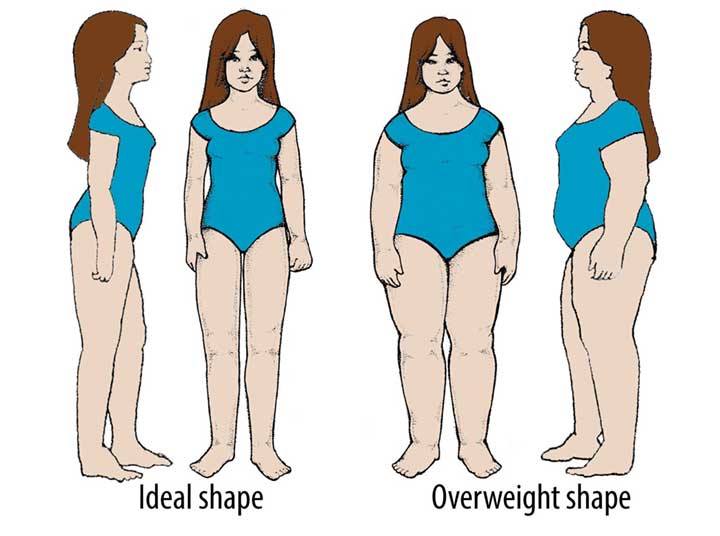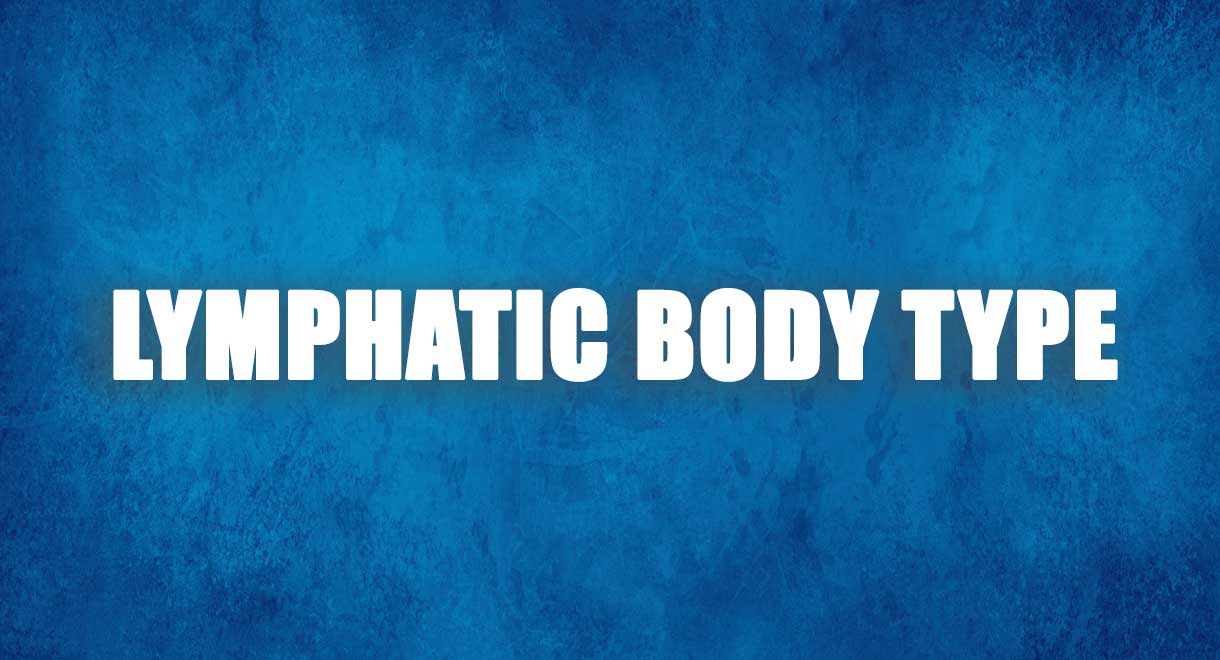Lymphatic Body Type
In the lymphatic-shaped woman, fat is generally distributed evenly over the entire body. The head and face are round in shape and the limbs are rather thick and straight up and down. The lymphatic-shaped woman appears more overweight than she really is, due to fluid retention in the fatty layers of the body. This may give a rather pudgy or swollen look to the feet, ankles, hands and wrists.
Fluid retention occurs because the return of fluid through the lymphatic vessels in the arms and legs is sluggish. The lymphatic vessels are often reduced in number and quality and this is hereditary. There is often poor muscle tone in the limbs, which further reduces the return of fluid back to the heart. Fluid tends to accumulate in the subcutaneous tissues (the layer of tissue underneath the skin) which exist between the skin and the muscles. So basically, their lymphatic system is inefficient.
The lymphatic system comprises a network of small tubes or vessels that collect subcutaneous and extracellular fluids. After the lymph fluid has circulated throughout the body and is cleansed by the lymph nodes, it returns to the general blood circulation via two large lymphatic vessels, known as the left and right lymphatic ducts. These ducts are situated in the upper chest and empty into large veins, which deliver venous blood to the right side of the heart. Thus, once the lymph fluid has performed its functions and is cleansed, it returns to the bloodstream via the heart.
These lymphatic vessels pass through lymph glands in the groin, abdomen and armpits, where the lymph fluid is filtered before emptying into the heart. In lymphatic-shaped women, the subcutaneous lymphatic vessels may be deficient in number and quality and may become enlarged and congested. This predisposes to puffy, thick limbs, which may contain so much excess fluid, that on pressing them with the finger tips, a dent is left on the limbs for several minutes. This is called “pitting edema” by doctors.
Lymphatic-type women often use diuretic drugs to try to control this retention of fluid that is such a common problem for them. Diuretic drugs stimulate the kidneys to excrete fluid and salt, which gives a temporary reduction in fluid retention. Unfortunately, diuretic drugs do not help the underlying weakness of the lymphatic vessels. Thus, the subcutaneous tissues remain spongy in nature and will swell when fluid once again accumulates in this layer. A more permanent solution is to use Liver Doctor’s Fluid Relief tablets on a daily basis; this natural formula will help to strengthen the lymphatic vessels.
The bones are not very obvious in the lymphatic body type, as they are covered by a thicker subcutaneous layer of fat and fluid. This contrasts with the thyroid body type, whose bone structure is very evident through their thinner subcutaneous layer of fat. The thyroid woman is the bony type, whereas the lymphatic woman is the cuddly, round type in appearance.
Because the network of lymphatic vessels and glands tends to be inefficient, problems with the immune system may occur, as the lymphatic system forms an important part of the body’s immune system. Thus, problems such as swollen glands, tonsillitis, excessive mucus or allergies may occur, especially if the diet is high in creamy dairy products or sugar. Excessive mucus and allergies may result in sinusitis, postnasal drip, hay fever, sore throats, bronchitis or asthma. These problems can be helped with supplements of N-Acetyl-Cysteine (NAC).
Lymphatic-type women usually crave dairy products and sugar, which are not metabolized efficiently by them and result in weight gain and mucus production in the body. To lose both excessive fat and fluid, lymphatic types need to follow a diet that is free of all dairy products and low in sugar.
A regular exercise program is vital for lymphatic body types. Good muscle tone in the limbs is essential to aid the muscular pump that stimulates the return flow of blood and subcutaneous fluid against the force of gravity upwards to the heart. Swimming, inverted yoga postures, using an inversion table, a trampoline, riding an exercise bike, bushwalking and power walking are excellent exercise strategies for lymphatic-shaped women. These types of exercise are often followed by an increased output of urine over the next 24 hours, as the kidneys excrete the excessive fluid returned to the heart by the muscles in the limbs during exercise.
Many lymphatic-type women are relatively inactive or sedentary in their lifestyle and have avoided sports during childhood. Indeed, they often dislike exercise and competitive sports, as unlike the thyroid types, they are not quick movers and they lack the enduring physical stamina of the android types. Their personalities are often relaxed and creative, so that they prefer indoor activities such as cooking, painting, reading or entertaining. So, it may take some time before a lymphatic-type woman can be coaxed into a regular exercise program. Unless this is achieved, it is very difficult for her to slim down her legs and arms and replace spongy subcutaneous tissue with muscle.
Lymphatic types will find it difficult to tolerate occupations requiring prolonged standing or sitting in one position all day, as without regular contraction of the limb muscles, fluid will quickly accumulate in the legs and feet.
The dominant gland in the lymphatic-type woman is the pituitary gland, which is situated at the base of the brain. The pituitary gland produces several major hormones and its main role is to control the thyroid gland, the adrenals and the ovaries. The pituitary gland can be considered the master gland of the body controlling, balancing and orchestrating the overall hormonal state.
Some doctors working in the field of obesity believe that an excess of dairy products in the diet causes an overstimulated state of the pituitary gland, which increases the tendency to obesity, especially in lymphatic types. In some women, a high consumption of dairy products stimulates the pituitary gland to overproduce the hormone prolactin. High levels of prolactin disturb the menstrual cycle causing infrequent menstruation (amenorrhea) and infertility. The avoidance of dairy products along with a selenium supplement and natural progesterone cream, will often cause abnormally high prolactin levels to reduce to normal. It is true that many lymphatic types of women crave dairy products such as milk, cheese, butter, cream, yogurt and ice cream. These foods are not easily metabolized in lymphatic types and predispose them to weight gain and excessive mucus.
Lymphatic women have a low metabolic rate and do not burn calories easily, so for them the avoidance of excessive weight is more difficult than for all the other body shapes. If a lymphatic type eats an ice cream, it will be converted to fat, whereas the thyroid-type woman will burn up its contained calories far more efficiently. This is somewhat unfair and the lymphatic woman needs to stimulate her metabolic rate with regular exercise and a dairy-free diet. The diet should be high in raw fruits and vegetables and fresh herbs and spices. The supplement called Metabocel can increase the metabolic rate and is safe to take as it is drug-free. Metabocel is a natural formula designed to stimulate a sluggish metabolism and makes the process of weight loss easier by speeding it up.
The sluggish metabolism of the lymphatic type can be stimulated by specific foods and nutritional supplements that increase the efficiency of the intracellular biochemistry. This will start to break down excess fat tissue, release retained fluid and improve the function of the lymphatic system.
To achieve this, I recommend that you regularly consume the following:
- seaweed
- sesame seeds
- garlic, chives, onion and radishes
- raw vegetable salads
- spices and herbs such as chili, paprika, fresh ginger, curry, turmeric, cinnamon, cilantro (coriander), basil, mint, parsley
- apple cider vinegar, one tablespoon in the middle of meals
- citrus fruits (oranges, lemons, grapefruits, limes, mandarins)
- raw vegetable juices such as carrot, celery, mint, beet, orange, lemon, parsley and ginger
- vitamin C with bioflavonoids, 1000 mg daily
- magnesium tablets or powder can help to reduce fluid retention and muscle cramps in those who use diuretic drugs
- dandelion, as coffee or fresh dandelion leaves in salads
The lymphatic body type in women

Each of the four different body types has unique hormonal and metabolic characteristics. That’s why some people put on weight easily and others don’t!
It is possible however to change the distribution of fat and muscle in your body, not only with exercise but also with the technique of nutrigenomics. Nutrigenomics is best described as turning off or on certain genes, by using specific supplements and foods. By regulating such genes, we can change our metabolism, our biochemistry, our hormonal balance and in the long term, our body shape.
Extra points for lymphatic women
Lymphatic women should reduce dairy products (milk, butter, cheese, cream, yogurt, ice cream, cream and chocolate). Margarine and high sugar foods should also be avoided. They must drink plenty of pure water. Regular exercise is essential to aid their sluggish lymphatic system They will benefit from spicy foods (ex. curries, chili, turmeric, paprika, cilantro, garlic and ginger etc.)
For lymphatic body types, the products that would be most suitable are Glicemic Balance, Magnesium tablets or powder, Fluid Relief, Vitamin D, Metabocel, NAC, and Fibertone (if constipation is associated).


Leave A Comment